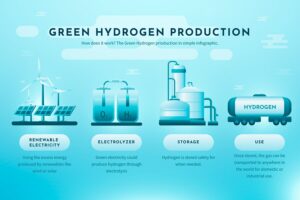The Emergence of Hydrogen Energy: A Comprehensive Analysis

Hydrogen energy has rapidly evolved as a critical contender for sustainable, clean energy sources. As the most abundant element in the universe, hydrogen has attracted significant attention from researchers, governments, and industries worldwide. This article delves into the technical aspects of hydrogen energy, its production, storage, and applications, as well as the challenges and opportunities that lie ahead.
- Hydrogen Production Methods
There are several methods for hydrogen production, with the primary ones being:
a. Electrolysis: This process involves using an electric current to split water (H2O) into hydrogen (H2) and oxygen (O2). The electrolysis efficiency largely depends on the type of electrolyzers used, such as alkaline, proton-exchange membrane (PEM), or solid oxide electrolyzer cells (SOEC).
b. Steam Methane Reforming (SMR): This is the most common method of hydrogen production, where methane reacts with steam at high temperatures (700-1000°C) to produce hydrogen and carbon dioxide (CO2).
c. Gasification: In this method, biomass or other carbonaceous materials are converted into a synthesis gas (a mixture of hydrogen, carbon monoxide, and other gases) by partial oxidation at high temperatures and pressures.
d. Photoelectrochemical (PEC) water splitting: This process uses sunlight and specialized semiconductors to generate the electric current needed for water electrolysis.
- Hydrogen Storage
Storing hydrogen safely and efficiently is crucial for its widespread adoption. The most common storage methods include:
a. Compressed Hydrogen: Hydrogen can be stored as a gas at high pressures (350-700 bar) in specially designed tanks made from advanced materials.
b. Liquid Hydrogen: Hydrogen can be stored as a cryogenic liquid at shallow temperatures (-253°C) in insulated containers.
c. Solid-state storage: Hydrogen can be stored in metal hydrides, carbon materials, and other solid materials through physisorption or chemisorption.
- Applications of Hydrogen Energy
Hydrogen can be utilized in a variety of sectors, including:
a. Transportation: Hydrogen fuel cells can power electric vehicles, with the only byproduct being water vapor. This can significantly reduce greenhouse gas emissions.
b. Power generation: Hydrogen can be used in gas turbines or combined-cycle power plants to generate electricity with reduced emissions.
c. Energy storage: Excess renewable energy can be stored as hydrogen, which can be converted back into electricity using fuel cells or gas turbines.
d. Industrial processes: Hydrogen can replace fossil fuels in high-temperature applications like steel production, cement manufacturing, and ammonia synthesis.
- Challenges and Opportunities
While hydrogen energy offers numerous benefits, several challenges must be addressed before it can become a mainstream energy source:
a. Production cost: Hydrogen from renewable sources is more expensive than fossil fuel-derived hydrogen. Further research and development are required to lower costs.
b. Infrastructure: The widespread adoption of hydrogen energy necessitates the development of robust distribution and refueling infrastructure.
c. Safety concerns: Hydrogen is flammable and has a wide flammability range, which raises safety concerns. These can be mitigated through careful system design, materials selection, and regulations.

Hydrogen energy presents a promising pathway toward a sustainable, low-carbon future. By addressing the challenges associated with hydrogen production, storage, and distribution, the world can harness its potential to revolutionize the energy landscape and mitigate climate change. As research and development efforts continue, hydrogen energy’s technical advancements will only become more remarkable, cementing its role as a vital component of a clean energy future.
One thought on “Hydrogen Energy”
Leave a Reply
You must be logged in to post a comment.
hydrogen production can also be facilitated by use of geothermal heat to hydrolyze water to hydrogen and oxygen. In certain of the Scandinavian countries where there’s a high concentration of geothermal this is actually done at hydrogen filling stations period I believe Shell is one of the innovators of that process distribution of hydrogen resulting from that hydrolysis. One specific initiative is in Iceland- see this article for further details.
https://www.thinkgeoenergy.com/planned-hydrogen-production-at-reykjanes-geothermal-plant/#:~:text=In%20an%20announcement%20today%2C%20Icelandic%20geothermal%20power%20company,will%20be%20used%20in%20the%20production%20of%20methanol.